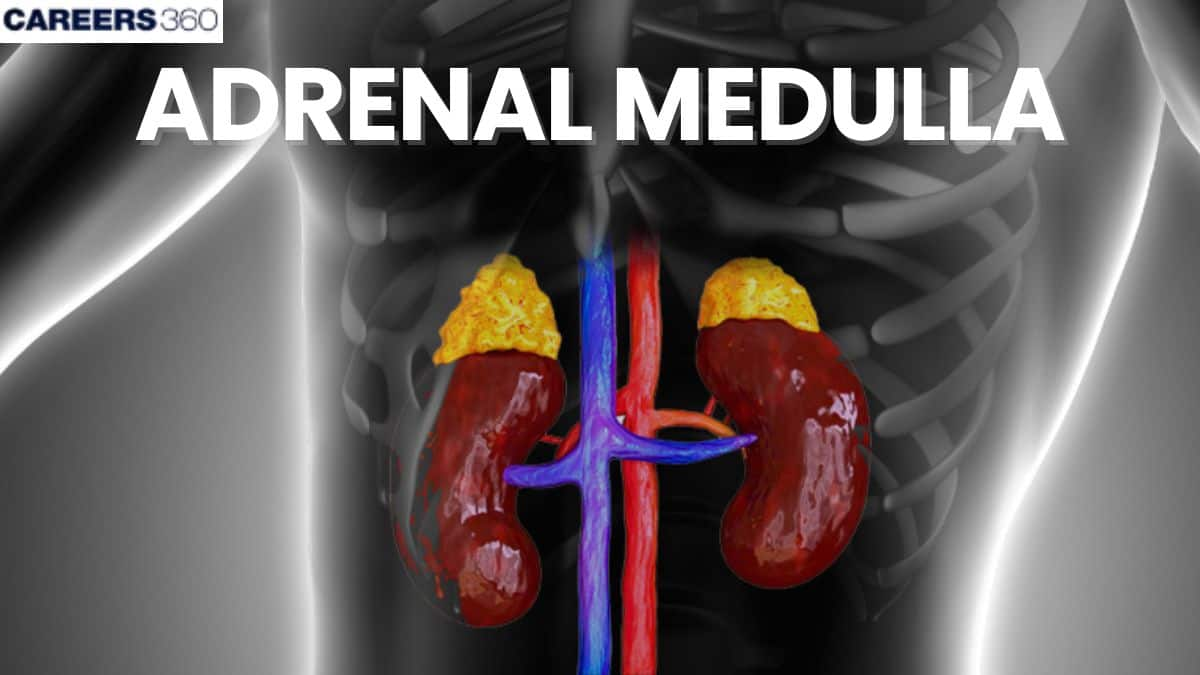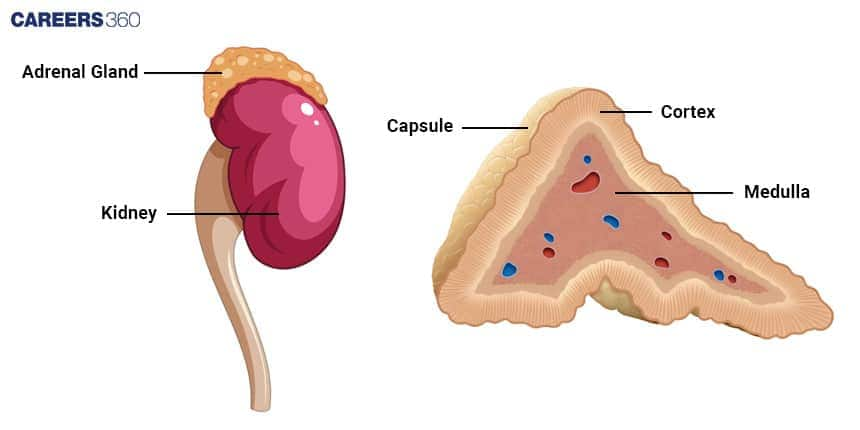Adrenal Medulla - Function & Diseases
The adrenal medulla is the inner part of adrenal glands that secretes adrenaline and noradrenaline. These hormones regulate the fight or flight response, helping the body manage stress. Understanding its structure, functions, and disorders is essential for Class 12 and NEET Biology.
This Story also Contains
- What is Adrenal Medulla?
- Anatomy of Adrenal Glands
- Structure of Adrenal Medulla
- Hormones of Adrenal Medulla
- Functions of Adrenal Medulla
- Disorders of Adrenal Medulla
- Diagnosis and Treatment
- Role in Stress Response
- Adrenal Medulla NEET MCQs
- FQS on Adrenal Medulla
- Recommended Video on Adrenal Medulla

The inner region of the adrenal gland is called the adrenal medulla. It is a modified sympathetic ganglion of the autonomic nervous system (ANS). It develops from the same embryonic tissue as all other sympathetic ganglia, but its cells lack axons. Rather than releasing a neurotransmitter, the cells of the adrenal medulla secrete hormones. The hormone producing cells, called chromaffin cells. The two major hormones synthesized by the adrenal medulla are epinephrine and norepinephrine, also called adrenaline and noradrenaline, respectively. The chromaffin in cells secrete an unequal amount of these hormones, about 80% epinephrine and 20% norepinephrine. Any imbalance in the secretion of these hormones causes disruption in the chemical control and coordination of the body.
What is Adrenal Medulla?
The paired adrenal glands or suprarenal glands, which lie superior to each kidney, have a flattened pyramidal shape. During embryonic development, the adrenal glands differentiate into two structurally and functionally distinct regions: adrenal cortex, and adrenal medulla.
The adrenal medulla accounts for 10% of the weight of the gland and is covered by the adrenal cortex. It produces three catecholamine hormones, norepinephrine, epinephrine, and a small amount of dopamine. These hormones are essential for the body's response to stressful conditions, thus maintaining physiological balance.
Anatomy of Adrenal Glands
There are two main divisions of the adrenal glands:
The outer region, or adrenal cortex, is the largest part of the gland. It has three subdivisions that produce different hormones: zona glomerulosa, zona fasciculata, and zona reticularis.
The section situated inner to the cortex, comprising 10% of the gland, is the adrenal medulla. It is responsible for producing adrenaline, which is also known as the stress hormone.
Both regions are surrounded by a layer of adipose tissue, which serves as a protective covering for the adrenal gland.
There are some specific cellular features of the adrenal medulla. They are:
In order to regulate adrenal medulla hormones, a specific blood supply is required.
The system of nerves known as the "greater splanchnic nerve" supports medullary communication with other parts of the body.
The chromaffin cells possess tiny granules that are released when the splanchnic nerve cells activate a response to stress. This signal leads to the circulation of adrenaline and noradrenaline in the blood.

Structure of Adrenal Medulla
The adrenal medulla is centrally located within the adrenal glands and is characterized by:
Chromaffin Cells
These cells are crucial in producing hormones. They will be irregularly shaped and located near blood vessels, thus allowing for the secretion of hormones into the bloodstream.
Cell Organisation
These chromaffin cells lie anatomically and functionally fine near blood vessels so that their release from the body takes place efficiently. They also connect with the autonomic nervous system which aids in regulating their activity.
Hormones of Adrenal Medulla
There are several important hormones produced in the adrenal medulla:
Epinephrine
Epinephrine is also known as adrenaline. It is released during stressful conditions. This peptide hormone increases heart rate, shifts blood flow to the muscles and the brain, and increases blood sugar to raise quick response.
Role of Epinephrine
Epinephrine is released by the medulla as a response to low blood sugar levels or while the body is in work or exercise mode. It shows a reaction to stress by body mechanisms such as:
It helps by sending oxygen to muscles at high levels.
It controls the rise in blood pressure and the required heart rate.
It widens the small arteries for easy blood circulation.
Norepinephrine
Norepinephrine is also known as nonadrenaline. Vasoconstriction is a reduced diameter of the blood vessels caused due to norepinephrine. Along with epinephrine, it increases blood pressure. The activities involve the body's 'fight or flight' response, usually including the maintenance of cardiac function.
Role of Noradrenaline
Noradrenaline causes the body to respond to stress by causing the following changes:
It causes an increase in blood sugar levels.
The blood vessels are narrowed down as required.
It causes a rise in blood pressure levels.
It also takes part in the brain’s function of storing memories.
It supports us in waking up.
It supports emotional abilities and health.
It gives us the strength to pay attention and be focused.
Dopamine
This catecholamine is produced in smaller amounts and represents the precursor to norepinephrine. It has an action on neurotransmission, mood, and regulation of motor control.
Functions of Adrenal Medulla
The major functions of the adrenal medulla are
Fight or Flight Response
It makes hormones like epinephrine and norepinephrine following the receipt of the 'stress' signal from the sympathetic nervous system. With its stimulation, it readies the body for immediate action with a racing heartbeat, blood supply to the muscles, and loads of energy.
Hormone Conversion
The medulla is concerned with the conversion of the amino acid tyrosine to epinephrine and norepinephrine. This function is vital in keeping up the 'preparedness' of the body to meet stress.
Disorders of Adrenal Medulla
Pheochromocytoma is the most common disorder directly related to the adrenal medulla. The literal meaning is a tumour of chromaffin cells causing excess production of epinephrine and norepinephrine. Some of the common symptoms include high blood pressure, tachycardia and sweating.
Diagnosis and Treatment
Pheochromocytoma and such related disorders are diagnosed based on the measurements of hormone levels from blood and urine, imaging studies like CT scans or MRIs, and biopsy if necessary.
This is mostly done through surgical removal of the tumour. At times medication is given before surgery which would lessen symptoms due to the controlled amount of hormones.
Role in Stress Response
It is because of the adrenal medulla that, during instances of acute stress, the human body gets its share of catecholamines, responsible for adjustments to be made in a range of physiological functions so that the organism receives properly set for an impending challenge.
Adrenal Medulla NEET MCQs
Q1. Fight - or - flight reactions cause activation of:
The parathyroid glands, leading to increased metabolic rate.
The kidney, leading to suppression of renin angiotensin - aldosterone pathway.
The adrenal medulla leads to increased secretion of epinephrine and norepinephrine.
The pancreas leads to a reduction in the blood sugar levels.
Correct answer: 3) The adrenal medulla leads to increased secretion of epinephrine and norepinephrine.
Explanation:
As we learned in Adrenaline and noradrenaline -
Adrenaline and noradrenaline are rapidly secreted in response to stress of any kind and during emergencies and are called emergency hormones or hormones of Fight or Flight
- wherein
These hormones increase alertness, pupillary dilation, piloerection (raising of hair), sweating, etc. Both hormones increase the heartbeat, the strength of heart contraction, and the rate of respiration. Catecholamines also stimulate glycogen breakdown, resulting in an increased glucose concentration in the blood. In addition, they also stimulate the breakdown of lipids and proteins.
Hence, the correct answer is Option 3) The adrenal medulla leads to increased secretion of epinephrine and norepinephrine.
Q2. Mary is about to face an interview. But during the first five minutes before the interview she experiences sweating, increased rate of heartbeat, respiration, etc. Which hormone is responsible for her restlessness?
Estrogen and progesterone
Oxytocin and vasopressin
Adrenaline and noradrenaline
Insulin and glucagon
Correct answer 3) Adrenaline and noradrenaline
Explanation:
Often referred to as stress hormones, adrenaline, and noradrenaline may be the cause of restlessness. Large amounts of epinephrine (adrenaline) and norepinephrine (noradrenaline) are released into the bloodstream when sympathetic nerves are stimulated to the adrenal medulla. These hormones are subsequently transported to all bodily tissues.
Hence, the correct answer is option 3) Adrenaline and noradrenaline.
Q3. A chemical signal that has both endocrine and neural roles is:
Epinephrine
Cortisol
Melatonin
Calcitonin
Correct answer: 1) Epinephrine
Explanation:
Hormones secreted by Adrenal Gland -The adrenal medulla secretes two hormones called adrenaline or epinephrine and noradrenaline or norepinephrine. These are commonly called catecholamines Epinephrine is a catecholamine and has both roles of hormone & neural.
Hence, the correct answer is option 1) Epinephrine.
Also Read:
FQS on Adrenal Medulla
Define the adrenal medulla.
The adrenal medulla is the inner part of the adrenal gland, surrounded by the adrenal cortex. It is made up of specialized neuroendocrine cells called chromaffin cells, which function like modified sympathetic neurons. The adrenal medulla is directly controlled by the sympathetic nervous system, making it a key part of the body’s “fight-or-flight” response. It releases catecholamine hormones into the bloodstream during stress or emergency conditions, enabling rapid body adjustments.
Which hormones are secreted by adrenal medulla?
The adrenal medulla secretes catecholamines, mainly adrenaline (epinephrine), noradrenaline (norepinephrine) and small amounts of dopamine. Adrenaline and noradrenaline are released quickly in response to stress, danger, or excitement. Adrenaline is the dominant hormone, accounting for about 80% of the secretion, while noradrenaline makes up the remaining portion. Together, they help the body respond rapidly to emergency situations by increasing alertness, energy availability, and cardiovascular activity. Dopamine is produced in smaller amounts and represents the precursor to norepinephrine. It has an action on neurotransmission, mood, and regulation of motor control.
What are the functions of adrenaline and noradrenaline?
Adrenaline has a stronger effect on the heart and metabolism, while noradrenaline mainly causes vasoconstriction to maintain blood pressure. Adrenaline and noradrenaline prepare the body for fight-or-flight responses:
Increase heart rate and blood pressure for efficient circulation.
Stimulate glycogen breakdown, raising blood glucose levels for quick energy.
Dilate bronchioles, improving oxygen intake.
Increase blood flow to muscles while reducing flow to digestive organs.
Enhance alertness and reaction speed.
What is pheochromocytoma?
Pheochromocytoma is a rare tumor of the adrenal medulla that causes excessive secretion of catecholamines (adrenaline and noradrenaline). This leads to symptoms like persistent high blood pressure, rapid heartbeat, sweating, anxiety, and headaches. The condition can be life-threatening if not treated because of extreme hypertension and cardiovascular complications. Diagnosis is done by measuring catecholamine levels and imaging of the adrenal glands. Treatment usually involves surgery and medications to control blood pressure.
Recommended Video on Adrenal Medulla
Frequently Asked Questions (FAQs)
The adrenal medulla is an essential part of the adrenal glands, which are part of the endocrine system. It plays a critical role in the body’s fight-or-flight response during stress.
The primary cells of the adrenal medulla are called chromaffin cells. These cells produce and release adrenaline and noradrenaline directly into the bloodstream.
There are two types of tumours that develop inside the adrenal glands: benign and carcinogenic.
Conn syndrome is caused by adrenal oversecretion.
There are two adrenal glands on the top of both kidneys, just below the ribcage.
The smaller part of the gland is the medulla, and the outer part is the adrenal cortex. The adrenal cortex makes up the largest area of the gland.